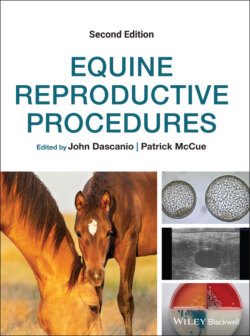Читать книгу Equine Reproductive Procedures - Группа авторов - Страница 92
Normograde Oviductal Flush (Laparoscopic Approach) Technique
ОглавлениеStanding procedure.
The mare is fasted for 24 hours prior to surgery.
Antibiotics and flunixin meglumine (1.1 mg/kg, IV, s.i.d.) are administered prior to surgery and after surgery as needed.
The mare is appropriately sedated; additional sedation may be required and administered as needed. In the original paper a combination of detomidine hydrochloride (0.01 mg/kg, IV) and butorphanol tartrate (0.01 mg/kg, IV) were administered.
The paralumbar fossa is prepared for laparoscopic surgery.
A local anesthetic is placed into the locations for the portal sites.
Three instrument portals are created and one portal for the laparoscope (Figure 29.1). The abdomen is insufflated with CO2 to allow for visualization of the internal abdominal structures.
A pair of laparoscopic Babcock forceps or oviductal forceps are used to grasp and open the edges of the infundibulum to view the ostium of the oviduct.
The balloon catheter is inserted into a guide sleeve and passed into the ostium and advanced distally toward the ampulla.
The cuff is inflated with 1.0–1.5 ml of air.
One Babcock forceps is removed from the infundibulum and repositioned behind the balloon cuff to secure the catheter in place during the flush procedure
The oviduct is flushed with 20 ml of sterile methylene blue solution.
The procedure is subsequently performed on the contralateral oviduct.
Hysteroscopy to visualize the oviductal papilla is performed during the flush to determine if the dye solution passed through each oviduct into the uterus.
The portal incisions are closed in a routine manner.
Figure 29.1 Landmarks for instrument portals: 1 is the laparoscopic portal; 2 and 3 are locations for the portals for the forceps; and 4 is the portal for the guide sleeve and catheter.
